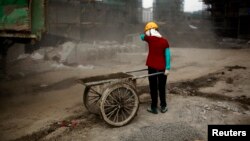GENEVA —
A new global treaty to tackle modern forms of forced labor has been overwhelmingly approved by 177 member states attending the annual International Labor Conference (ILO) in Geneva. One country voted against, and seven abstained.
The treaty spells out ways to prevent, protect and compensate victims of forced labor.
The International Labor Organization estimates 21 million men, women, and children around the world are in forced labor, an illegal enterprise that generates about $150 billion a year.
The ILO adopted two Conventions on Forced Labor, in 1930 and 1957. The new protocol brings these two outdated Conventions into the 21st century.
International Labor Committee on Forced Labor President David Garner says the treaty focuses on contemporary forms of slavery. It tackles practices such as human trafficking.
“I think the key aspects are that it calls on member states to give effect to their obligation to suppress forced labor as enshrined in Convention 29 - by strengthening in particular prevention and protection measures, by enabling victims to access remedies, such as compensation and to sanction the perpetrators of forced or compulsory labor," he said. "There was also consensus within the committee that the punishment of offenders is important, but it is also equally important to ensure that the rights of victims are protected.”
The ILO says victims of forced labor often are treated like criminals instead of people in need of assistance. The head of the ILO’s special action program on forced labor, Beate Andrees, says the new protocol remedies this injustice.
“There is one important provision now in the protocol to protect victims from being punished for criminal activities they may have been forced to carry out while they were in forced labor. Some victims, for instance, are forced to plant drugs or to traffic drugs,” Andrees said..
The ILO estimates 55 percent of forced labor victims are female, 45 percent are male, and 26 percent are children. Victims may be in bonded labor or working under slave-like conditions in a wide range of industries.
The ILO says women and girls are primarily forced into domestic work and commercial sexual exploitation, while men and boys are in forced economic exploitation in agriculture, construction, and mining. It says many work long hours, often for little or no pay.
Two states must ratify the protocol for it to go into force and individual governments must ratify the new protocol to become legally bound by its provisions.
Thailand reportedly voted against the treaty while Bahrain, Brunei, Iran, Kuwait, Oman, Qatar, Saudi Arabia and Yemen abstained.
The treaty spells out ways to prevent, protect and compensate victims of forced labor.
The International Labor Organization estimates 21 million men, women, and children around the world are in forced labor, an illegal enterprise that generates about $150 billion a year.
The ILO adopted two Conventions on Forced Labor, in 1930 and 1957. The new protocol brings these two outdated Conventions into the 21st century.
International Labor Committee on Forced Labor President David Garner says the treaty focuses on contemporary forms of slavery. It tackles practices such as human trafficking.
“I think the key aspects are that it calls on member states to give effect to their obligation to suppress forced labor as enshrined in Convention 29 - by strengthening in particular prevention and protection measures, by enabling victims to access remedies, such as compensation and to sanction the perpetrators of forced or compulsory labor," he said. "There was also consensus within the committee that the punishment of offenders is important, but it is also equally important to ensure that the rights of victims are protected.”
The ILO says victims of forced labor often are treated like criminals instead of people in need of assistance. The head of the ILO’s special action program on forced labor, Beate Andrees, says the new protocol remedies this injustice.
“There is one important provision now in the protocol to protect victims from being punished for criminal activities they may have been forced to carry out while they were in forced labor. Some victims, for instance, are forced to plant drugs or to traffic drugs,” Andrees said..
The ILO estimates 55 percent of forced labor victims are female, 45 percent are male, and 26 percent are children. Victims may be in bonded labor or working under slave-like conditions in a wide range of industries.
The ILO says women and girls are primarily forced into domestic work and commercial sexual exploitation, while men and boys are in forced economic exploitation in agriculture, construction, and mining. It says many work long hours, often for little or no pay.
Two states must ratify the protocol for it to go into force and individual governments must ratify the new protocol to become legally bound by its provisions.
Thailand reportedly voted against the treaty while Bahrain, Brunei, Iran, Kuwait, Oman, Qatar, Saudi Arabia and Yemen abstained.










